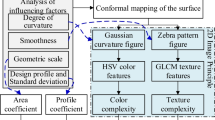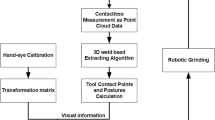Abstract
The On-machine measurement (OMM), which measures a workpiece during or after the machining process in the machining center, has the advantage of measuring the workpiece directly within the work space without moving it. However, the path generation procedure used to determine the measuring sequence and variables for the complex features of a target workpiece has the limitation of requiring time-consuming tasks to generate the measuring points and mostly relies on the proficiency of the on-site engineer. In this study, we propose a touch-probe path generation method using similarity analysis between the feature vectors of three-dimensional (3-D) shapes for the OMM. For the similarity analysis between a new 3-D model and existing 3-D models, we extracted the feature vectors from models that can describe the characteristics of a geometric shape model; then, we applied those feature vectors to a geometric histogram that displays a probability distribution obtained by the similarity analysis algorithm. In addition, we developed a computer-aided inspection planning system that corrects non-applied measuring points that are caused by minute geometry differences between the two models and generates the final touch-probe path.
Similar content being viewed by others
References
S. Biasotti, S. Marini, M. Mortara, G. Patane, M. Spagnuolo and B. Falcidieno, 3D shape matching through topological structures, Proc. of Discrete Geometry for Computer Imagery, Naples, Italy (2003) 194–203.
D. Bespalov, A. Shokoufandeh, W. C. Regli and W. Sun, Scale-space representation of 3D models and topological matching, Proc. of the 8th ACM Symposium on Solid Modeling and Applications, Seattle, USA (2003) 208–215.
N. Iyer, Y. Kalyanaraman, K. Lou, S. Jayanti and K. Ramani, A reconfigurable 3D engineering shape search system part I: shape representation, Proc. of ASME DETC 03 Computers and Information in Engineering Conference, Chicago, USA (2003) 89–98.
H. Sundar, D. Silver, N. Gagvani and S. Dickinson, Skeleton based shape matching and retrieval, Proc. of Shape Modeling International, Seoul, Korea (2003) 130–139.
A. Elinson, D. S. Nau and W. C. William, Feature-based similarity assessment of solid models, Proc. of the 4th ACM Symposium on Solid Modeling and Applications, Atlanta, USA (1997) 297–310.
D. McWherter, M. Peabody, A. C. Shokoufandeh and W. Regli, Database techniques for archival of solid models, Proc. of the 6th ACM Symposium on Solid Modeling and Applications, Ann Arbor, USA (2001) 78–87.
A. Cardone, S. K. Gupta, A. Deshmukh and M. Karnik, Machining feature-based similarity assessment algorithms for prismatic machined parts, Computer-Aided Design, 38 (9) (2006) 954–972.
S. Kim, K. Lee, T. Hong, M. Kim, M. Jung and Y. Song, An integrated approach to realize multi-resolution of B-Rep model, Proc. of the 2005 ACM Symposium on Solid and Physical Modeling, Boston, USA (2005) 153–162.
R. Osada, T. Funkhouser, B. Chazelle and D. Dobkin, Shape distributions, ACM Transactions on Graphics, 21 (4) (2002) 807–832.
C. Y. Ip, D. Lapadat, L. Sieger and W. C. Regli, Using shape distributions to compare solid models, Proc. of 7th ACM Symposium on Solid Modeling and Applications, Saarbrucken, Germany (2002) 807–832.
W. Wohlkinger and M. Vincze, Ensemble of shape functions for 3D object classification, Proc. of Robotics and Biomimetics, Phuket, Thailand (2011) 2987–2992.
R. Ohbuchi, T. Otagiri, M. Ibato and T. Takei, Shapesimilarity search of three-dimensional models using parameterized statistics, Proc. of Computer Graphics and Applications, Beijing, China (2002) 265–274.
Author information
Authors and Affiliations
Corresponding author
Additional information
Recommended by Editor Haedo Jeong
Hyesung Jeon has worked for Optimus Systems Inc. (www.optimus-sys.com), Korea. He received his master’s degree in industrial system engineering in 2016 at Ajou University. His current research interests are geometric modeling, parametric feature modeling and human simulation.
Jinwon Lee is a Ph.D. student in the department of industrial engineering at Ajou University, Korea. He obtained his master’s degree in industrial engineering in 2012 at Ajou University. His current research interests are geometric modeling, human simulation and 3-D simulation in virtual reality environment.
Jeongsam Yang is a Professor in the department of industrial engineering and is leading the CAD laboratory (http:// cadlab.ajou.ac.kr) at Ajou University, Korea. He worked at Carnegie Mellon University (USA) and Clausthal University of Technology (Germany) as a visiting researcher, and the University of Wisconsin-Madison (USA) as a postdoctoral associate. He obtained his Ph.D. in mechanical engineering in 2004 at KAIST. His current research interests are product data quality (PDQ), VR application in product design, product data management (PDM), knowledge-based design system and geometry modeling.
Rights and permissions
About this article
Cite this article
Jeon, H., Lee, J. & Yang, J. A touch-probe path generation method through similarity analysis between the feature vectors in new and old models. J Mech Sci Technol 30, 4705–4716 (2016). https://doi.org/10.1007/s12206-016-0941-8
Received:
Revised:
Accepted:
Published:
Issue Date:
DOI: https://doi.org/10.1007/s12206-016-0941-8




